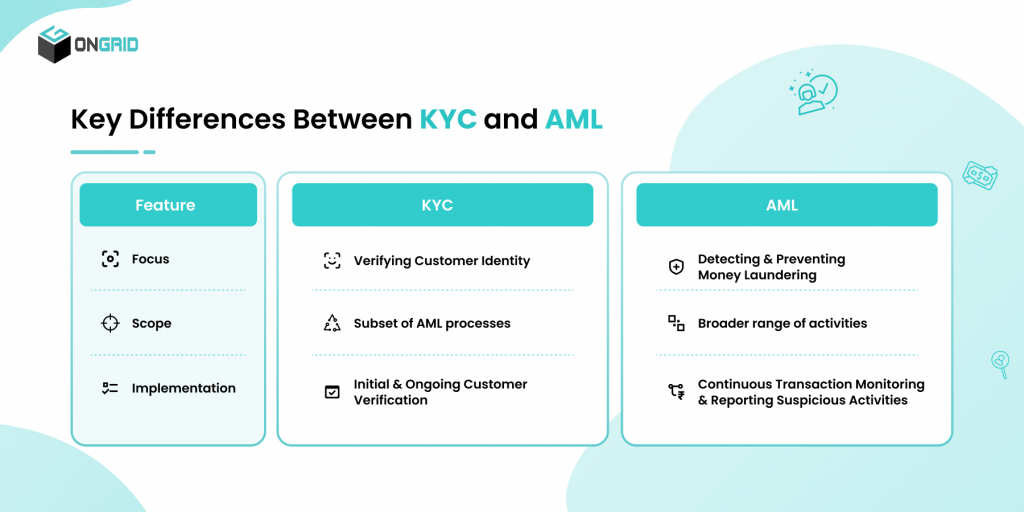In the financial services industry, adhering to regulatory standards is essential to maintain the integrity and security of financial transactions. Two critical components of these regulatory frameworks are Know Your Customer (KYC) and Anti-Money Laundering (AML) protocols. While often mentioned together, KYC and AML serve distinct purposes and are implemented through different processes.
Banks, businesses, and customers must understand KYC and AML to prevent financial crimes effectively. KYC involves verifying the identity of clients to prevent fraud, whereas AML focuses on detecting and preventing the laundering of illicit funds. Both processes are vital for ensuring the security and integrity of the financial system.
This blog provides a detailed examination of KYC and AML, outlining their definitions, components, and significance. We will also explore the key differences between these processes, their interconnected nature, and best practices for their effective implementation. By the end of this guide, you will have a thorough understanding of KYC and AML, equipping you to handle the complexities of financial compliance more efficiently.
What is KYC?
KYC, or Know Your Customer, is a process used by financial institutions to verify the identity of their clients. It is designed to prevent fraud, money laundering, and other illegal activities by ensuring that customers are who they claim to be.
Components of KYC
- Customer Identification Program (CIP): Collecting and verifying customer information such as name, address, date of birth, and identification numbers.
- Customer Due Diligence (CDD): Assessing the risk level of the customer based on their background and financial activities.
- Enhanced Due Diligence (EDD): Additional scrutiny for high-risk customers to ensure thorough vetting.
Importance of KYC
- Prevents Identity Theft: By verifying the identity of customers, KYC helps prevent identity theft and related financial fraud.
- Regulatory Compliance: Financial institutions are required by law to comply with KYC regulations to avoid penalties and legal issues.
- Risk Management: KYC processes help institutions assess and mitigate risks associated with new and existing customers.
Read Also: Understanding eKYC: What It Is and the Importance of Validation APIs
What is AML?
AML, or Anti-Money Laundering, refers to a set of laws, regulations, and procedures designed to prevent criminals from disguising illegally obtained funds as legitimate income. AML policies aim to detect and report suspicious activities that could be indicative of money laundering or terrorist financing.
Components of AML
- Transaction Monitoring: Analyzing financial transactions to identify unusual patterns that may indicate money laundering.
- Suspicious Activity Reports (SARs): Filing reports with regulatory authorities when suspicious transactions are detected.
- Compliance Programs: Implementing internal policies and training programs to ensure adherence to AML regulations.
Importance of AML
- Combatting Financial Crime: AML measures are essential for identifying and preventing money laundering and other financial crimes.
- Maintaining Financial System Integrity: Effective AML programs help maintain the trust and integrity of the financial system.
- Regulatory Compliance: Adhering to AML regulations is mandatory for financial institutions to avoid fines and reputational damage.

The Interconnection of KYC and AML
KYC and AML are interconnected in their goal to prevent financial crimes. Effective KYC processes lay the foundation for robust AML programs. By thoroughly verifying customer identities and assessing risk levels, institutions can more effectively monitor transactions and identify suspicious activities. Together, KYC and AML create a comprehensive defense against financial fraud and money laundering.
Challenges and Best Practices
Challenges:
- Data Management: Handling and securing large volumes of customer data can be challenging.
- Regulatory Changes: Keeping up with evolving regulations requires continuous adaptation.
- Resource Allocation: Implementing comprehensive KYC and AML programs can be resource-intensive.
Best Practices:
- Leverage Technology: Utilize advanced analytics, APIs, and machine learning to enhance KYC and AML processes.
- Continuous Training: Regularly train employees on the latest regulations and detection techniques.
- Collaboration: Partner with experienced KYC and AML service providers to ensure a comprehensive approach to compliance and data management.
Conclusion
KYC and AML are fundamental components of financial regulation that work together to prevent financial crimes and protect the integrity of the financial system. While they serve different functions, their interconnection is crucial for effective risk management. By understanding the differences and implementing best practices, financial institutions can ensure compliance, enhance security, and build trust with their customers.
At Gridlines, we offer a suite of APIs designed to streamline and enhance your KYC and AML processes. Our APIs provide seamless integration with your existing systems, enabling efficient customer verification, continuous monitoring, and comprehensive risk assessment. By integrating Gridlines APIs into your KYC and AML workflows, you can achieve greater operational efficiency, reduce manual errors, and ensure robust compliance with regulatory requirements. Embrace the future of financial security with Gridlines and safeguard your institution against financial crimes.
For more information on how Gridlines APIs can support your KYC and AML efforts, visit our website or contact our team for a personalized consultation.





Leave a Reply